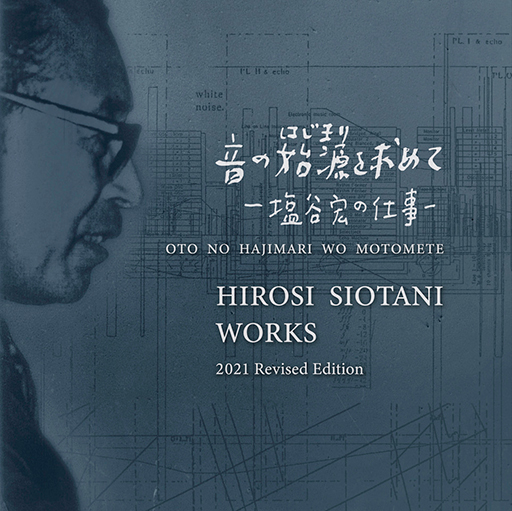
音の始源を求めて
塩谷 宏の仕事
2021改訂版
The Beginnings of
Japanese Electroacoustic
Vol.1
HIROSI SIOTANI works
2021 Revised Edition
- 《素数の比系列による正弦波の音楽》 黛 敏郎 1955年
“Music for Sine Wave by Proportion of Prime Number” Toshiro Mayuzumi 1955 - 《素数の比系列による変調波の音楽》 黛 敏郎 1955年
“Music for Modulated Wave by Propotion of Prime Number” Toshiro Mayuzumi 1955 - 《鋸歯状波と矩形波のためのインヴェンション》 黛 敏郎 1955年
“Invetion for Square Wave and Saw-tooth Wave” Toshiro Mayuzumi 1955 - 《7のヴァリエーション》 黛 敏郎・諸井 誠 1956年
“Variations on numerical principle of 7” Toshiro Mayuzumi&Makoto Moroi 1956 - 《テーマ音楽》 諸井 誠 1957年
“Program Theme Music” Makoto Moroi 1957 - 《ピタゴラスの星》 諸井 誠 1959年
“Stars of Pythagoras” Makoto Moroi 1959 - 《ヴァリエテ》 諸井 誠 1962年
“Variété” Makoto Moroi 1962 - 《オリンピック・カンパノロジー (大阪万博用再編版)》 黛 敏郎 1970年
“Olympic Campanology” Toshiro Mayuzumi 1970 - 《テレムジーク》 カールハインツ・シュトックハウゼン 1966年
“Telemusik” Karlheinz Stockhausen 1966
内容紹介
-
1.「素数の比系列による正弦波の音楽」黛 敏郎
2.「素数の比系列による変調波の音楽」黛 敏郎
3.「鋸歯状波と矩形波のためのインヴェンション」黛 敏郎 - 音程、強さ、持続時間を素数比から算出、 正弦波、鋸歯状波、方形波(短形波)、ホワイトノイズ発信器を使って制作された。着想にあたってはシュトックハウゼン「習作1」を参考とした部分音構成を基準に素数の比を選んだ。
- 4.「7のヴァリエーション」黛 敏郎 & 諸井 誠
- 12音技法の音列作法から発想した音列で倍音のでてこない音列 (49√7n×70として、70Hz-10015Hz)の音階が使用された。この音列は主として純音、短形波、鋸歯状波に当てはめられ、ホワイトノイズはオクターブ・ フィルターによってバンドカットが行われており、この組み合わせによって一種の音階が形成されている。 数列は周波数選択の構成、対位法、強弱、エンベロープ、時間要素にも適用された。
- 5.「テーマ音楽」諸井 誠
- モノラルからステレオへの移行期に作られた、実験的秀作群。音響合成の実験をくり返しながら電子音楽の製作技術をみがき、スタジオの設備改善や製作器械類の補充を重ねた。これまでのモノラルにはディメンジョンという概念は存在しなかったが、この作品以降、目の前に拡がるステレオフォニックの世界では音が自由に動き回った。
- 6.「ピタゴラスの星」第1部「沈黙の環」諸井 誠
- 電子音だけではなく、モノローグや合唱、様々な楽器音、 電子楽器オンド・マルトゥノ等、あらゆる発音体を音源とした。この曲ではピタゴラス的発想からの数列一音列作法が用いられているにも関わらず、音の時間的変化に対する音色の変化により叙情的な劇作品となった。
- 7.「ヴァリエテ」諸井 誠
- 数学的音列作法を否定し、音程、強弱、リズム、持続時間の出現率をカード、乱数表等によって不確定、ランダムに分布したチャンス・オペレーション作法が用いられた。持続時間とレベル分布についてそのランダム性を強調するため手作業で制作、又、リズムに関してはテープの手切り編集による技術の極限であると伝えられる。
- 8.「オリンピック・カンパノロジー (大阪万博用再編版)」黛 敏郎
- 梵鐘の音を基本に作曲されたこの曲は1964東京オリンピックの開会式、天皇陛下の入場のために制作された。鐘の音色を決定する要素が、鐘を打たれた瞬間のトランジェットの期間に決定されると言うことを基本的な理論として作成されている。
- 9.「テレムジーク」カールハインツ・シュトックハウゼン
- 奈良のお水取りや雅楽。アマゾン、南サハラ、スペインの片田舎あるいは中国からの音素材をコラージュ的に用いた(オリジナルは)5チャンネルの作品。この作品で彼は「電子音による想像の過程では3つの異なった要素=時間、歴史(伝統)空間を一緒にする事が出来ると」述べている。
Introduction
-
1. “Music for Sine Wave by Proportion of Prime Number” Toshiro Mayuzumi
2. “Music for Modulated Wave by Propotion of Prime Number” Toshiro Mayuzumi
3. “Invetion for Square Wave and Saw-tooth Wave” Toshiro Mayuzumi
- The pitch, intensity, and duration were calculated from the prime ratio, and were produced using sine wave, saw tooth wave, square wave (short wave), and white noise generator. For the idea, the ratio of prime numbers was selected which is based on the partial sound composition with reference to “Study 1” by Stockhausen.
- 4. “7 Variations” Toshiro Mayuzumi & Makoto Moroi
- The tone rows that was gotten the idea from the tone rows method of the twelve- tone technic and that did not include harmonic overtones (49√7n × 70, 70Hz-10015Hz) was used. This tone rows are mainly applied to pure tone, short wave, and saw tooth wave, and white noise is band-cut by the octave filter, and this combination forms a kind of scale. The sequence was also applied to frequency selection configurations, counterpoints, strengths, envelopes, and time elements.
- 5. “Program Theme Music” Makoto Moroi
- 6. “Pythagoras Star” Part 1 Mamoru Moroi
- Not only electronic sounds, but many other sounds were used: monophonic and choral, various musical instrument sounds, electronic musical instruments such as Ondes Martenot, and so on. This work was a lyrical dramatic work due to the change of the timbre with respect to the temporal change of sound, despite the use of a number sequence (tone sequence method) from the Pythagorean idea.
- 7. “Variete” Makoto Moroi
- Denying mathematical sound sequence, the Chance Operation method was used, with the appearance rate of pitch, strength, rhythm, and duration being uncertain and randomly distributed using cards, random numbers, etc. It is said that there are limitations to this method’s technique because tapes are edited by hand, with respect to the rhythm, the duration and the level distribution.
- 8. “Olympics Campanology” Toshiro Mayuzumi
- This work, which was composed based on the sound of the temple bell, was created for the opening ceremony of the 1964 Tokyo Olympics and for the admission of the Emperor. The basic theory is that the element that determines the tone of the temple bell is determined during the transit period of the moment the temple bell is struck.
- 9. “Telemuzik” Karl Heinz Stockhausen
- This is a five-channel work that uses collage of materials from Amazon, South Sahara, Spanish countryside or China, and Nara Omizutori and Gagaku music. In this work, he states, "In the process of imagination with electronic sound, three different elements = time and history (traditional) space can be brought together."
BUY
- Official Online Shop
- https://sound3.buyshop.jp/items/72395677
- Amazon
- https://www.amazon.co.jp/dp/B07SK8SCZF/
- CDに関するお問い合わせ
- denshi-ongaku@sound3.co.jp
Manufacture Distribute by Sound 3 Co., Ltd. (P)2020
制作/有限会社 サウンドスリー
企画/大阪芸術大学音楽工学OB有志の会
Sound 3 Co., Ltd.
#404 Style House Ebisu 3-34-14 Ebisu Shibuya-ku Tokyo Japan zip 150-0013